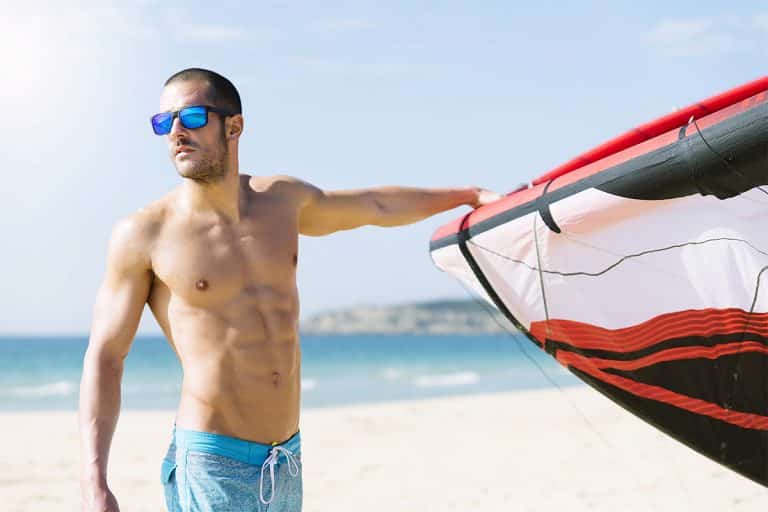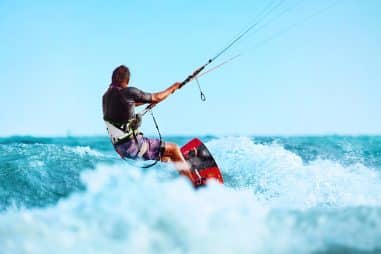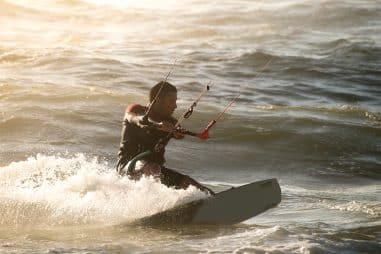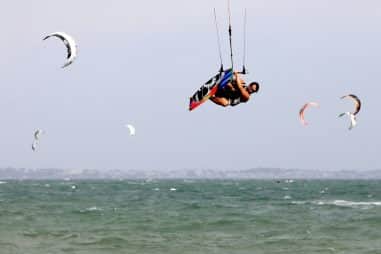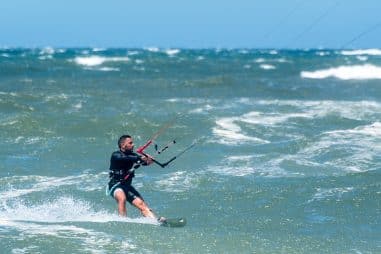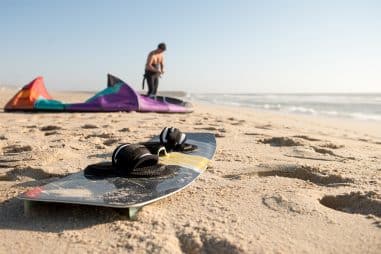Kitesurfing is piquing the interests of people of all ages and gender. It is an extreme water sport that is not only good for the body but is also great for training your mind.
Is Kitesurfing a Good Exercise?
Kitesurfing is a good holistic exercise that does not just work your body but also your mind. You are in for some intense workout especially if you will be subject to strong wind and water conditions.
The activity combines the principles of aerobic and muscle workout. With the work that you are set out to do while kitesurfing, it’s as If you are spending time at an actual gym.
How Does Kitesurfing Get You Fit?
Your whole body will benefit when you start kitesurfing. It is a whole-body workout that moves basically even the smallest part of your body. Some of its benefits include:
- A toned body: Kitesurfing is primarily a muscular kind of work that will work your core muscles. You will also work your arms and legs.
- A healthy heart: All the moves that you will be doing while you are kitesurfing will keep your heart pumping. It is a good cardio exercise.
- Increased coordination and concentration: Because you will be doing a lot of tasks at the same time, your body and mind will be trained to be more coordinated.
- Improved balance and reflexes: You will be standing on a board cruising through the waves while a lot of things are happening to you. This will be one of the first things that you will improve on. You will also be trained to make fast decisions on how to move your body in the right positions especially in difficult situations.
- Boost your immune system: The activity will not only boost your endorphins but will also eliminate stress.
How Many Calories Does Kitesurfing Burn?
The calorie-burning aspect of kitesurfing varies from person to person and on the wind speed on which they are kitesurfing.
A person weighing 130 pounds can burn around 600 calories when kitesurfing in 12-15 knots for around one hour. On the other hand, a person who weighs more (say, 175 pounds) can burn at least 1,000 calories per hour of kitesurfing at the same wind speed.
Remember that you will burn more calories if the wind condition is stronger and the water condition is choppier. Good news to you, ladies! Studies have shown that women burn slightly more calories while kitesurfing than their male counterparts.
Does Kitesurfing Build Muscle?
Kitesurfing is one sport that extremely tones and builds your muscles. It helps strengthen your arms and upper body since you have to do several tasks while balancing yourself. The sport engages a lot of your muscles, especially when carving upwind. Aside from that, pulling hard into your harness will also work muscles extra hard.
You have to remember, though, that the workout these muscles get will depend highly on how long you do the activity and whether you ride upwind.
What Muscles Does Kitesurfing Work?
Kitesurfing primarily engages your core muscles including:
- Ab muscles
- Lower back muscles
- Deeper core muscles
- Transversus abdominis (muscles along the sides of your abdominal wall)
- Multifidus (deep back muscle extending down your spine)
- Leg muscles
- Quads
- Hamstrings
- Calves
How Fit Do You Need to be to Kitesurf?
Although you often see muscled men do kitesurfing, you don’t necessarily have to be as muscular as them to be able to kitesurf. Even kids can learn to kitesurf and go out into the water. Contrary to popular belief, it is not your super-fitness that dictates if you can kitesurf or not.
More often than not, it’s the proper handling of the kite that enables people to do the activity. You just need to be fit and healthy enough, and more importantly, you need to be comfortable in the water. With the tension of pulling the harness on your kite, you would eventually get those muscles anyway if you stay on the sport.
Is Kitesurfing Bad for Your Back?
Due to the tension on your back muscles, kitesurfing may induce back pain especially on the lower back or lumbar area. In fact, back pain is one of the most common injuries that you can get from kitesurfing.
The good news is, there are ways on how to prevent back pain like a good muscle stretch before going into the waters. It is recommended to perform some abdominal and lumbar muscle exercises to help your body get ready for the activity.
How Much Do You Have to Weigh to Kitesurf?
There are no rules on the ideal weight to be able to kitesurf. Kitesurfers seem to enjoy the sport no matter their weight and size.
There are also kite and board sizes that are adapted to the different weights which makes the sport much more accessible to all kinds of people.
Is There a Weight Limit for Kitesurfing?
There is no written weight limit for kitesurfing. People of all ages and sizes seem to be able to do the activity rather well when paired with a good instructor and an even better kite.
You can always talk to and get recommendations from professional instructors or your friendly kite sales rep so you would know what kind of kite will best fit your weight.
Why Is Kitesurfing Dangerous?
Kitesurfing is considered to be an extreme sport (and dangerous) due to its high-risk nature. There are a lot of aspects that go into the sport and with one of them going out of place may result in accidents.
A lot of things can go wrong on a kitesurfing adventure including kite errors, equipment failures, and water hazards.
What Are the Dangers of Kitesurfing?
There are several dangers that kitesurfing poses.
- Errors made by kitesurfers:
- Losing control of the kite: In some cases, Kitesurfers may lose control of their kite. This may lead to being dragged out into the sea or onto an object without being able to let go of the kite before the impact.
- Launch or landing failure: Against your better judgment, you might launch your kite even in the presence of strong winds. On the other hand, during landing, you might fail to lower your kite at the edge of the window. This may also lead to being dragged out of control out of the water.
- Getting wiped out in the waves: You might take off even if there are bigger waves. This will result in losing tension on your lines, your kite dropping off, a big wave coming in, and you getting washed out. You might end up tangled in your lines while being beaten by the waves.
- Weather and nautical hazards:
- Sudden wind change: The wind might change at a moment’s notice and you might get caught up when it suddenly picks up strongly. The strong winds can drag you upwards. The wind can also suddenly drop which can leave you drifting in offshore currents.
- Strong currents: You might get reach an area of strong currents and you might get caught in the current without any means of swimming or paddling out of it.
- Big waves: If you mistakenly steer your kite to a wave zone, you might not get out of it fast enough before you get washed out.
- Equipment failure:
- Kite line snapping: There are many parts of the kite that might fail or break. A kite line might snap causing you to be dragged out of control.
- Breaking hardness spreader bar: Your harness spreader bar might also snap on one side causing you to be dragged on your side by the kite lines.
- Quick release trigger: Your quick release may be triggered and might go off accidentally. This might cause an accident if you are near an obstacle or other people
- Obstacle hazards: With unpredictable wind, weather, and water, you might just be dragged out into an in-water obstacle or be blown out into an obstacle on land.
- People hazards: Choosing an area with ample, unobstructed space is paramount. Otherwise, you might collide with another kitesurfer, or worse, with a jet ski or boat.
- Ocean hazards: Aside from the water being unpredictable, there are also underwater elements that might pose a risk for you. There are sea urchins and weever fish to sting you sharks that might attack you, and you might even hit a shallow coral reef that might cut your skin or break your board.
- Health hazards: Your own health should also be given priority because a lot of things may happen if you suddenly get ill while kitesurfing. Some have experienced getting cramps, back pain, and hypothermia. There are also cases of riders getting severe sunburns and eye damage caused by ultraviolet rays.
Can You Die Kitesurfing?
People have died while kitesurfing for many different reasons. In 2013, a kitesurfer in Western Australia died while kitesurfing at Cottesloe Beach. According to reports, the man tripped near the edge of the water. He was then launched into the air by his kite.
While the activity does not necessarily always end in death if you are not cautious enough to prevent any accident that you might encounter while kitesurfing, this may lead to very serious situations.

